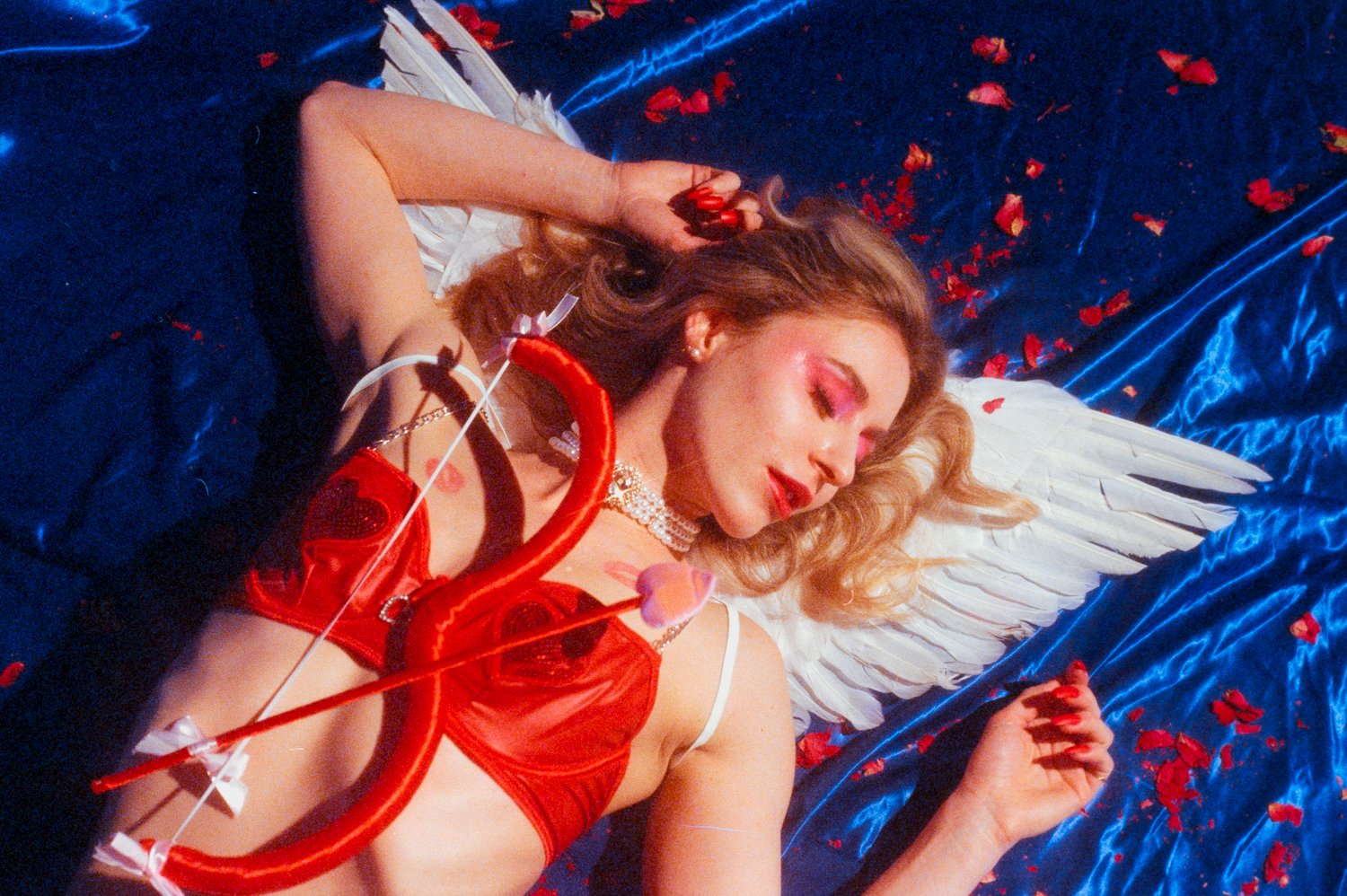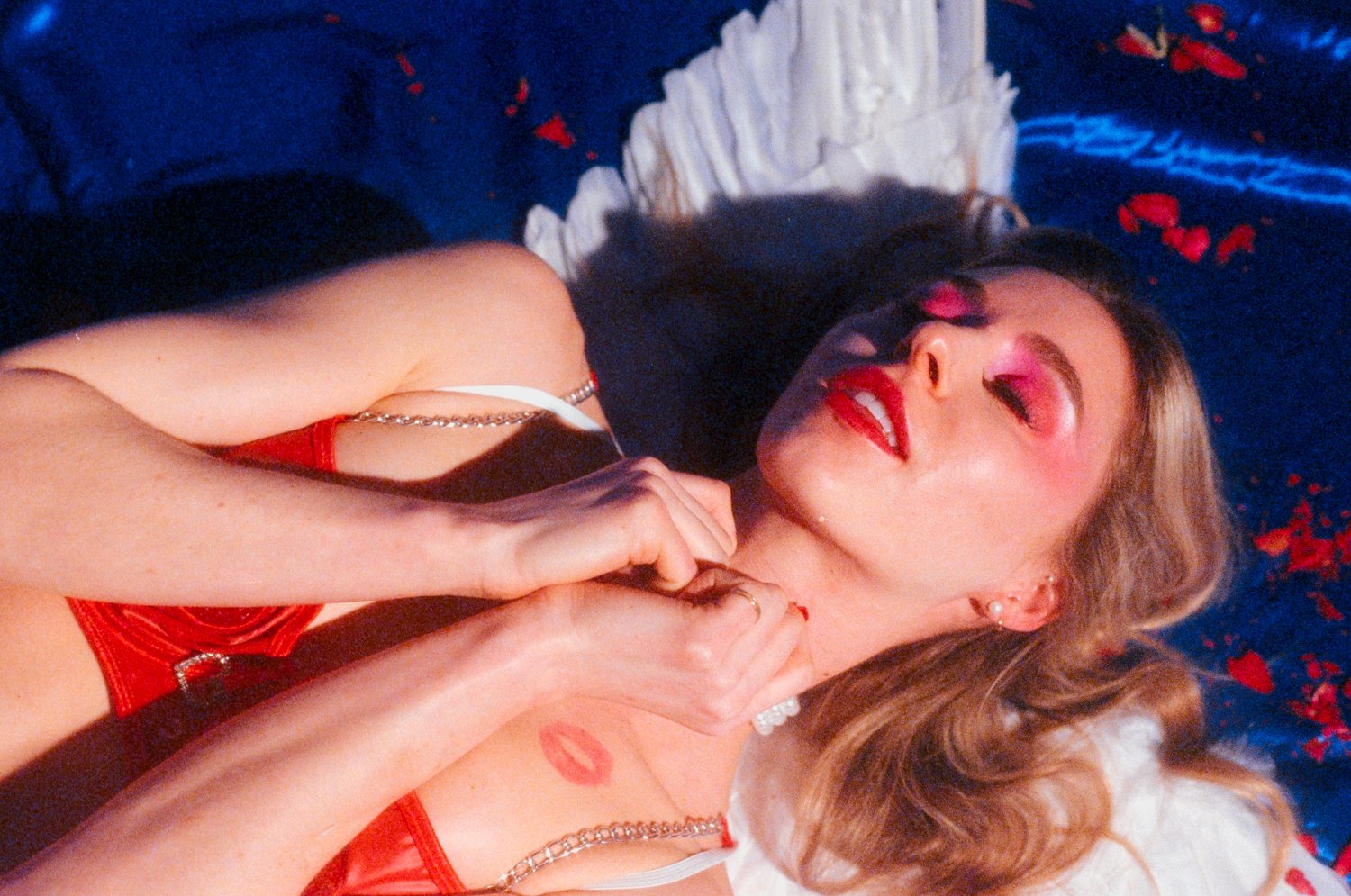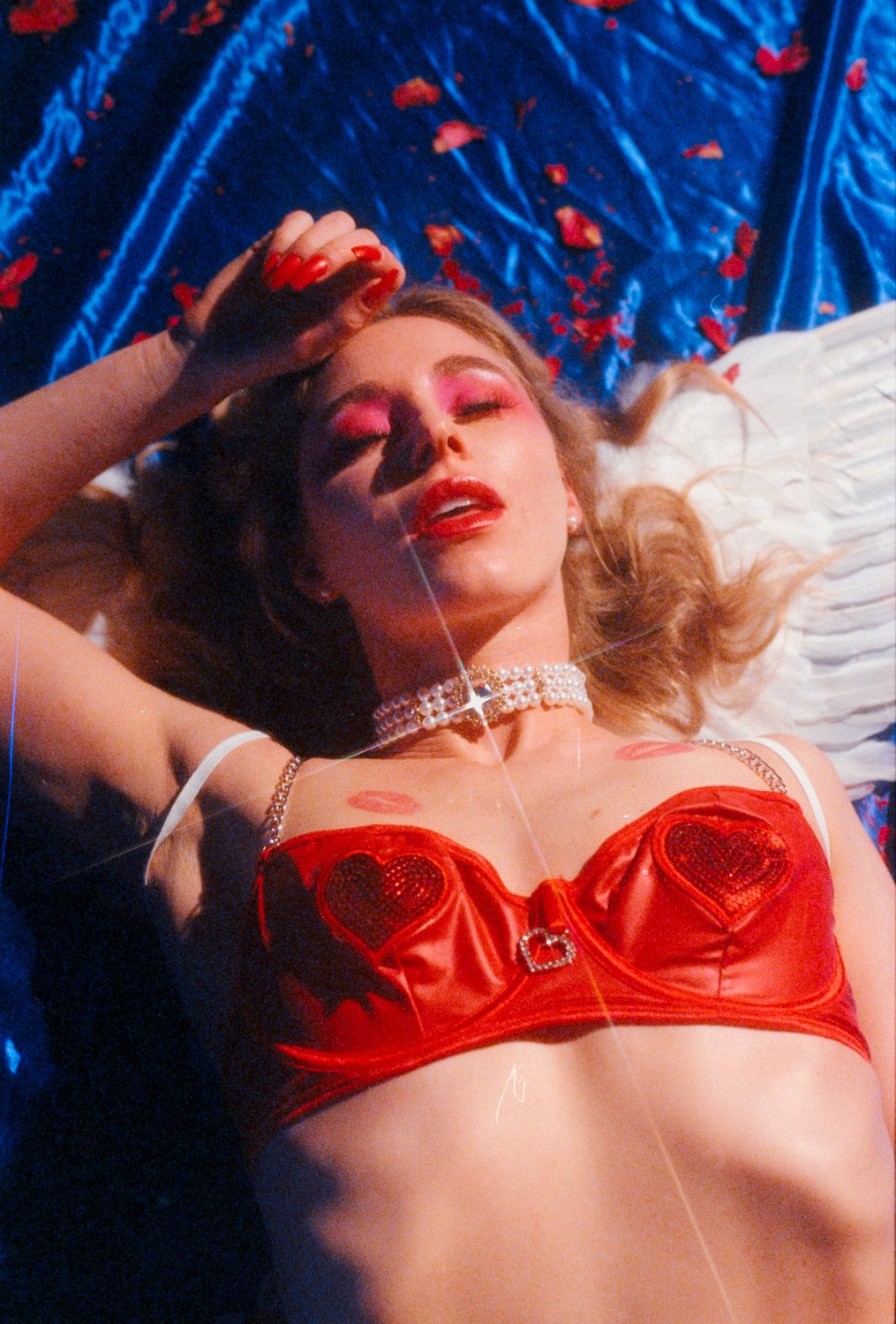Photo Diary: In the Mood for Love? Koltin Sullivan Will Have You Catching Feelings & An Appreciation for Analog Photography
IN THE SPIRIT OF THE MONTH OF LOVE — analog photographer Koltin Sullivan led a Valentine’s Day shoot, collaborating with Sara Slayton as his model. The project not only plays on familiar commercial characters of love, as portrayed by Slayton’s Cupid, but also radiates a playful dreaminess — in some ways visualizing the initial stages of being in love.
Sullivan picked up analog photography in 2018, after watching modelographers in Maine, and hasn’t looked back since. Since then, he’s traveled to over 36 states in pursuit of perfecting his craft, learning about natural lighting and how to utilize his analog equipment. Despite losing stability due to the pandemic and personal health issues in 2020, which kept him from being able to shoot, Sullivan didn’t let anything interfere with his analog passion.
From his bedside, he was able to create and sell film-processing chemistry kits all over the world, before joining the team at CineStill in November of the same year. Today, Sullivan is able to partake in and enjoy every step of the highly technical art form that is film photography. He shoots 35 mm, 120, Super 8, and 16 mm, and processes everything from a darkroom in his home.
Check out Sullivan and Slayton’s shoot and interview below to learn about film photography, how they captured the Valentine's Day vision, and their love languages!
[FOR KOLTIN]
LUNA: The shoot was obviously inspired by Cupid in honor of Valentine’s Day. There are so many ways you could have executed this theme of love — how did you settle with this specific vision?
SULLIVAN: It’s always the question of “how can I attempt to convey this concept given my resources?” I don’t like working with too much — I prefer less. I’m usually around less, and it forces creativity. If I had a budget and more help, maybe I would prefer more. I saw other Valentine’s-themed shoots and I felt like this one had a place in the ecosystem since it was different. It wasn’t overwhelming, it was simplistic, and almost felt like a vintage Valentine’s Day card. I wanted to revive that energy and remind people of the craftfulness and feeling of vintage sets. I know if I was able to set the environment right Sara would be easily able to live in that world — easy for her to play “make believe” or “pretend.” It has a playful quality to it — it’s warmer that way. I’ve lived on the road and it’s been rough at times. Photography is a love, and love is pushing through the hardships with the little I had. I love shooting in abandoned places — I don’t know why but I’m attracted to the energy; it’s a blank canvas, and turning nothing into something, body movement and emote… that’s what I want to play with. I’ve also been watching a lot of Lynch lately, and maybe I built off Blue Velvet a bit. I settled on this specific vision because for a studio set it represented that abandoned distant energy the most.
LUNA: The photos have a very dreamy energy to them. How are you hoping they will portray your perception of love and romance?
SULLIVAN: I wanted an ominous/dreamy setting — we don’t know what’s behind the curtain, which makes it limiting, but the staples of the cherubs are in there with the wings and arrow, so it feels fairytale-like. The mix of those two are sort of contrasted. It’s those subconscious nuances and details that bring it home for me. I used a single light from the 1960s, and it has this warm quality of light and old reflector housing. One variable that helps the shoot is the star filter. I double stacked an 85 and star filter on top of each other. I took one look into my viewfinder and said, “It would be great to have a star filter,” and Dustyn, who was doing BTS and owns the studio, miraculously had one. Without that filter, it wouldn’t have been as effective. There are also a few shots with lower shutter speeds, 1/30, where I was moving the camera while taking them to add more blur. The blur reminds me of the soul of the person. I hope all these portray a sense of warm, hazy romance.
LUNA: What was probably the most difficult part of the shoot? Any frustrating moments or technical difficulties?
SULLIVAN: The process, regardless how challenging, is what keeps it fun and exciting. The minute I dread any aspect of it is when I know I lost it and don’t love it. I’ll always be a student of photography and I’ll always be learning. So when circumstances may be categorized as “frustrating” or “difficult,” it’s more of an opportunity to expand and grow. It’s a positive — you almost seek it. The variable that was prominent was how to play the concept. Did I want it energetic, or sensual, or stoic, and how does the set support that? Sara is a big personality so I [knew] we could push it if we wanted to, but I wasn’t worried about the delivery at all. Typically outside the creative, the logistics are “the work,” like, “I know I want hearts, but what kind of hearts, and are they big or small, and how many, and where to place them?” Those silly questions about details are the ones I’m always perplexed by, and in my opinion are harder than the actual shoot. But when I figure it out, it’s like solving a puzzle — it’s rewarding. Additionally, when you have artistics you trust working with you, you dance with the stream of consciousness and ideas flow. When they are at a standstill, you keep moving, but look at it with no preconceived ideas, then an idea comes and you grab it. The key is not to force anything.
LUNA: Photography can be a pricey talent and hobby to maintain, especially with film photography requiring all these physical elements to process. Despite this, what drew you to analog over digital when you first started shooting?
SULLIVAN: Brianna Fern, a model and photographer in Maine, invited me over in 2017. I saw her shoot analog on a farm in Maine in a Gunne Sax dress and I thought it was the most beautiful thing. I was swooned by the beauty of Maine and her shooting analog. I kept flying back from LA and I started to meet other analog shooters in New England, like my friends Anna, Darien, and Maria. It became my world — I was so intrigued. It was so different from LA. Maybe that’s what I needed to be inspired by, just a different environment. The community was small and unbelievably nice; I always had a place to stay, and it felt like home. Maine is a place of freedom — it’s a place of experimenting, and because of this, [this] is what analog represents: ultimate freedom. Now in 2023, analog is popular and that's a great thing, but prices have risen dramatically and working cameras are getting harder to find — they are being picked over. The popularity can also make price gouging seem normal.. mix that with inflation and a seller might reason to upcharge a camera that cost $250 in 2017 to at least $700 in 2023. I make chemicals myself, I process myself, and have resources for obtaining film so my costs are extremely low. I learned about making chemistry and that opened my world to even more learning and complete creative control. It’s the only way I can allow myself to do it.
LUNA: Shooting analog is definitely an entire experience that extends beyond shooting the photos itself. What was your favorite part of this process, start to finish?
SULLIVAN: Photographic film has a history of over 100 years — these cameras have stories and energy to them, and there’s a ton of options so there’s something for everyone. I love researching and seeing the cameras change by era. I’ve learned about engineering, marketing, math, and philosophy just by diving into analog. I love the tactile element — I feel like an artist that way. There are films and filters that allow you to capture beyond what the eye can see, [and] that is magic. Whether you shoot 35 mm, 120, large format, instant film, Super 8, or 16 mm, there’s always something to reach for and learn. I shot digital for a few years, but the uniformity of the glass lacked character and feeling. I started to shoot with Sonnar/Biogon Zeiss lenses on my Sony α7R II and then I started studying optical glass and why I liked the look, sort of reverse-engineering it. It turns out I like the low element, low group lenses. I like the early stuff, the lenses with optical flare, no coating, less modification of the light — that’s character, and I adapted it into my work, gritty. Shooting analog allows you to connect with your subject deeply. All of a sudden, each frame counts, you’re on a team, and [you] can take risks now that you know how you’re operating. Delayed gratification is rare now and such a change of experience. Processing yourself allows you total creative control. For instance, you can add contrast and saturation or roll off the highlights if needed; you can cross-process and mix dye couplers with different developers or skip bleach completely. That’s why it’s important to pre-visualize and know how to use a spotmeter. I’ve streamlined my process and built a dryer, and I use a camera scan set-up. Although I enjoy each part of this process, because each process has an art to it I would say choosing the overall look and developing a concept is my favorite part of this process.
[FOR SARA]
LUNA: Is there anything you had to do to prepare yourself before or during the shoot to help execute Koltin’s Valentine’s vision? How do you usually mentally prepare for your shoots?
SLAYTON: For me, preparation is all about imagination. Before the shoot, I said to Koltin, “Let’s get into it. Who is my character? What is her backstory? Why is she here?” He didn’t miss a beat. Before the camera clicked, we’d created something. That’s one of my favorite things about shooting with Koltin. He is right there with me, imagining a story that hasn’t been told yet, breathing life into it, something that feels right for both of us.
LUNA: What was your favorite and least favorite part of the process?
SLAYTON: My favorite part of shooting is creating — the feeling of connectedness when you collaborate on a shared vision. The intimacy of film. The satisfaction of your final shot. The film hasn’t been developed yet, you haven’t seen a thing, but you feel full knowing you’ve created. You’ve turned your energy and imagination into something tangible. I find that sense of release really, truly beautiful. Oh, and my least favorite part: taking my makeup off after. I want to keep it on forever, and taking it off is a whole to-do.
LUNA: What's your love language (to give and receive) and the most simple thing someone can do that makes you feel seen?
SULLIVAN: Time is the best gift to give and receive. That’s the only thing that is limited. If someone chooses to spend time with you, that’s something special to cherish.
[FOR SARA AND KOLTIN]
LUNA: How do you show the people in your life love?
SULLIVAN: I spent time with them, I listen to them, I laugh with them, and eat with them. I’ll always remember that — it’s a memory.
SLAYTON: My ranking has shifted throughout the years, but my number one has always been touch, both to give and receive. That being said, I feel the most seen when someone is fully there, wholeheartedly attentive and experiencing life with me without judgment or expectation. I’m not sure which love language this falls under — if it’s the thread across or a love language in and of itself. But I do think presence is the greatest gift we can give each other.
-
weekly tunes playlist has been updated! new tracks from @furtradeband, @pecqband, @garryfool & more! check it out! https://t.co/ToFU0R6YGo












